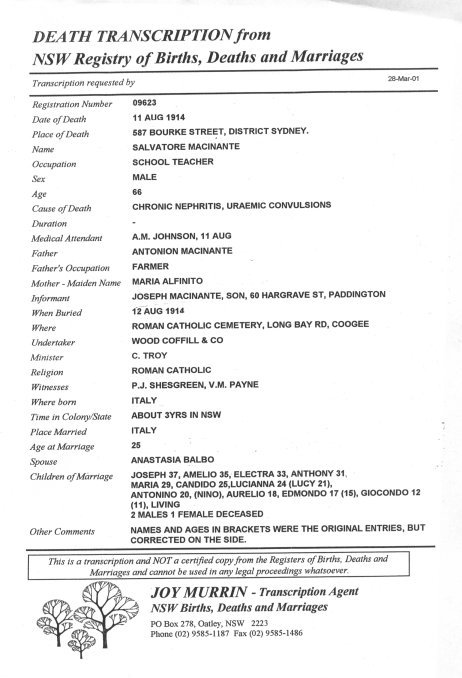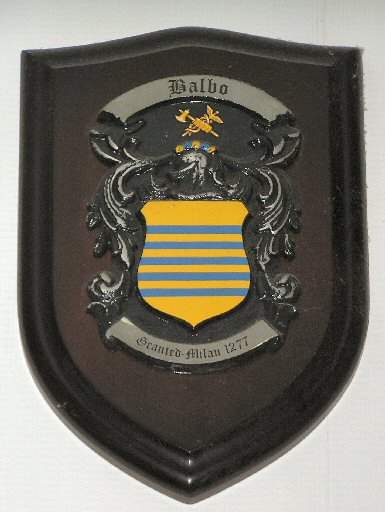A "SIGNAL" FAILURE.
My Grandfather Salvatore Macinante left a small Italian village in 1912 with his wife
and seven children, persuaded by the four sons who had settled happily in Australia,
my father at Narrandera.
Nonno died less than two years later, a lonely exile, and although I never knew him I
treasure the sad letter he wrote on a country train, 13th August 1912 :-
|
We are in a comfortable carriage of the Sydney - Melbourne railway stopped at a
Country Junction waiting for the train from Narrandera. I would like to see a town, but
all I see through the window is sky.
What do these people do in their spare time?
All they do is pray for rain and they work no more than they have to.
There are three of us in a second class carriage - my son Candido, myself and an
Englishman or Australian.
He at first wished to speak to me, but I could not answer him as I could not yet
express myself in English.
I feel ashamed that a man like me, having taught school for thirty eight years in
Italy, is now just like a junior scholar.
I find myself so far away from my Country - with people I do not understand, the
different dress and, for me the awful language.
It is 3:00am - the train is stopped at Goulburn. There is a Prison here for the
unfortunate ones sentenced to six months or more in jail.
To this place many come to try to make a fortune, but I prefer life in Old Europe.
We are travelling like this for hundreds of kilometers - then it is daylight, we are able to see
things - some trees!
I would like to see an olive tree - but there are none.
Things are so far from one another, desolate shepherd's huts, but there is no sign of a
human being - I cannot see a living thing.
Finally it is bright daylight and everything is much clearer.
Vast expanses of land - sometimes flat, then in small steep valleys.
Lots of arid land, and some covered with stubble - some has been sown for fodder, barley
and grain.
Immense defenceless land, in which, as though lost, wander cows, oxen, horses and
sheep.
We are beginning to see pairs of rabbits, some birds and parrots.
Later we arrive at the station of Cootamundra in an area uninhabited by human race.
Only timber huts a long way from each other, and always the same country, with sparse
native trees and stumps.
Some groups of houses, separated by hills and valleys - Fields freshly sown - grain and
barley already out of the ground. But where are the men? Who does the work?
Some flocks of sheep already shorn, are the only pastoral pursuit, without a shadow of
man to guide them and guard them
Some hovels and huts are scattered around, fruit bearing orchards and some poor
vegetable patches, which would benefit from the hand of man.
These are neglected and in an almost wild state.
The sub-soil is bared and arid starved sheep tear blades of grass out of the
ground.
On arriving at one of those unusual groups of huts which are called towns, we
see many wild ducks feeding on the open ground, many bags of grain wait to be
loaded on the railway.
Here is Junee-Junction and we change trains.
Travelling in a northerly direction and barely outside the station was to be seen
an immense endless plain, but it was the same wheat country, some ploughed
fields, some where wheat had germinated.
One man is driving six horses drawing a plough.
We arrive at Coolamon - There under a great zinc covered shed is a deposit of
large bags filled with wheat.
I would like to see the harvesting of these great crops of cereals and see how
this land of Australia sends it's grain to the Old World of Europe.
This great land with grain and more grain germinating as far as one can see.
In front is a stand of trees. Oh! I wish they were olive trees.
But it is always the same - a great deposit of wheat at Ganmain. Around here are
groups of houses of a newly developed town - Nearby is a Saw Mill supplying
timber for building.
As usual there are endless fields of growing wheat - Some birds and a few
poultry - Vultures circle in the distance. Given the nature of this vast territory many
more species of birds should be seen, but lack of water is the reason.
This would be Heaven on Earth if there was water and the cultivation
of fruit trees in this area. I speak of irrigation but it would need an inland sea
of canals.
The small tanks, made of zinc, beside the houses to gather the
rainwater, provide barely enough for the need of man.
Narrandera rises up in a boundless plain, Mostly uncultivated, on
which exists thin and boney cattle and poor poultry - Dry and arid from the
long drought this year.
Cultivation of grain here is extensive, ploughing and sowing is done by
machinery pulled by up to ten horses driven by one "Yokel".
Harvesting of the grain is done by machines which do the reaping,
threshing and bagging at the one time.
Hay and other fodder, which mixed with some wheat, is separated and
bagged. This mixture the English call "Chaff". Which is fed to horses and
other animals.
Some vegetable grow by the river, and by the canals fed by rain water.
Cultivated by some Chinese, who are the only ones prepared to grow
garden vegetables.
A long railway line, with no branch lines, runs to the Capital,
Melbourne - From Junee, which is halfway.
Distances between towns is great. Here live the "Country Blokes" Country Pastoralists in various numbers. These towns of 300 people, and up
to 3 and 4 thousand, have several hotels.
|
The original, translated from Italian, was unfinished.
- Anastasia Cuddy.
|
Salvatore's Journey Centenary
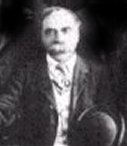
|
Our family patriarch, Salvatore Macinante 1848-1914, after coming to Australia late in his life travelled from Sydney to Narrandera in 1912 and fortunately for all of us he recorded his thoughts. Some of his thoughts extracted from A "SIGNAL" FAILURE follow:
|
Salvatore:
1912 |
"We are in a comfortable carriage of the Sydney – Melbourne railway"
|
I'm trying to retrace Salvatore's journey as near as possible to his experience. In 1912, which was a long time before most people owned a car, nearly everyone travelled by train. Salvatore made use of train services provided in that era, so train travel had to be my choice.
In 1912 trains were hauled by a steam locomotive. There is still a rail passenger service to Narrandera so I'm in the Xplorer - a "diesel multiple unit" train - no locomotive.
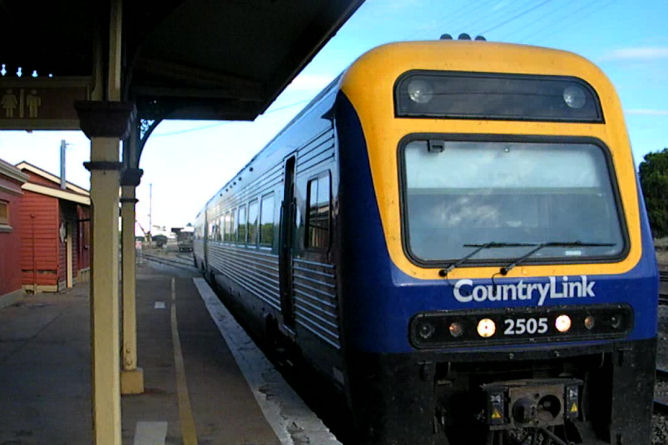
The Xplorer arriving at Narrandera
It is a rail journey which, like Salvatore's journey, will take me to Narrandera but I won't have the romance of the steam engine (locomotive) so I won't be closing the window to avoid the smoke when the train goes through a tunnel. In fact the windows on the Xplorer don't even open! To help me imagine Salvatore's steam engine experience I have my MP3 player making "Puff, Puff" noises in my ears and I'm imagining that the air coming from the Xplorer's air-conditioner smells of coal smoke.
| Salvatore: |
"I find myself so far away from my country – with people I do not understand ,
the different dress and for me the awful language."
|
I recall language difficulty I had travelling by train to Salvatore's home village in Italy, at the time I wished that, like some other descendants, I could converse in the Italian language.
| Salvatore: |
"It is 3:00 am - the train is stopped at Goulburn."
|
The old steam trains worked hard climbing up onto the southern highlands, they might have needed a water refill there.
At Goulburn station there is a water tower relic from the steam train era. Was it used for Salvatore's train?
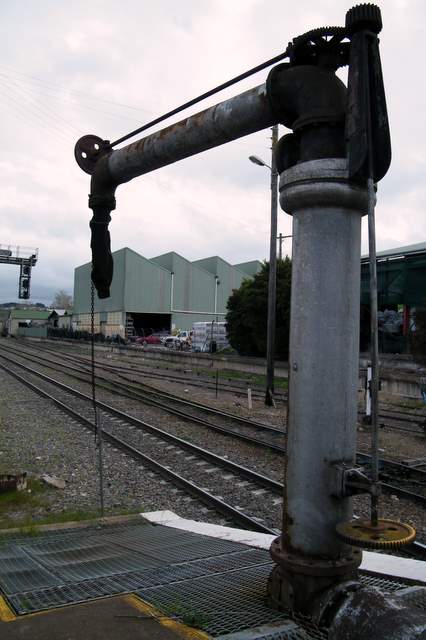
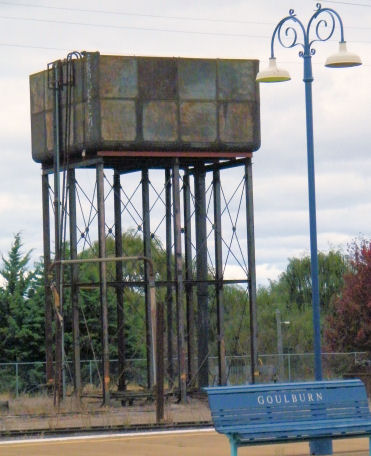
|
Water Towers were used to fill steam engines quickly with a large volume of water
|
|
"Salvatore: |
"... then it is daylight, we are able see things – some trees!
I would like to see an olive tree – but there are none."
"Things are so far from each other, I cannot see a living thing"
"Lots of arid land and some covered with stubble – some has been
sown for fodder, barley and grain"
"Immense defenceless land in which, as though lost, wander
cows, oxen, horses, and sheep"
"We arrive at the station of Cootamundra in an area uninhabited by human race."
|
The population of Cootamundra now is 7,500.
Salvatore recorded observations in this part of Australia which will never be witnessed again - history in the making
| "Salvatore: |
"Here is Junee - Junction ... We are stopped waiting for a train from Narrandera ... we change trains."
|
My Xplorer now leaves the Sydney - Melbourne "main south" line to go on the Griffith branch line, unlike Salvatore I didn't have to change trains.
| "Salvatore: |
"We arrive at Coolamon - There ... is a deposit of large bags filled with wheat."
"This great land and more grain germinating as far as one can see."
"In front is a stand of trees! Oh I wish they were olive trees."
|
If Salvatore could see the Murrumbidgee Irrigation Area now.
| "Salvatore: |
"Narrandera rises up in the boundless plain"
|
Except for the very flat and extensive plain, the picture which Salvatore conveys of very sparse habitation I could only imagine.
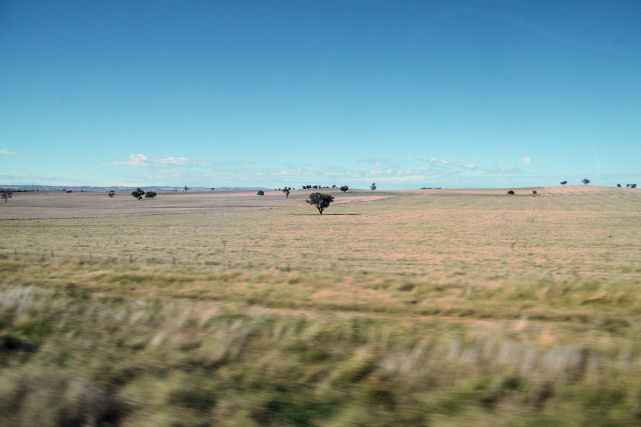
Farm land near Narrandera
If Salvatore had finished his notes I wonder if he would have commented about the grand old 1881 Narrandera station, in those times it was a busy junction; North: Griffith, Rota change for Broken Hill. South: Tocumal change for the Victorian network(closed 1986). East: Junee change for Sydney or Melbourne. West: Hay (now partially closed – no passenger service)
| Salvatore: |
"This would be a Heaven on Earth if there was water
and the cultivation of fruit trees in this area."
"I speak of irrigation but it would need an inland sea of canals"
|
At the end of my adventure following Salvatore along the rails a century after him and reading Salvatore's notes,
A "SIGNAL" FAILURE
, I'm reminded that it was people like him with vision of what could be that we have to thank for what we have today.
A century from now probably there will not be a train service to Narrandera creating much more difficulty for future descendants to follow Salvatore's journey, I'm glad I had the opportunity to experienced Salvatore's journey as best as I could in 2011. A century from now the train I travelled on might be an item in a museum and the countryside near Narrandera might be more like today's city outer suburbs.
Michael Macinante
2011
|
BALBO ITALO [1896 -1940]
Italian statesman and aviator, born in Quartesano and educated at the University of Florence and at the Institute of Social Science in Rome. He was an officer in the Italian army during World War I; later he became active in the fascist movement in Italy, in 1922 he participated in the Fascist March on Rome, helping the Italian dictator, Benito Mussolini (q.v.) to seize control of the government. Balbo held several important posts in the Fascist regime, notably in the Black Shirt Militia, in the Air Fleet and the Air Ministry which he headed from 1929 to 1933, in 1933 he commanded a group of twenty four airplanes on a flight from Italy to the United States. He was promoted to the rank of air marshal in that year and appointed Governor of Libya. He died in an aeroplane crash while serving as commander in chief of Italian armed forces in North Africa, a post to which he had been appointed in 1937.
|
|
Funk & Wagnall Encyclopedia
|
|
|


